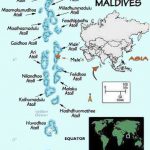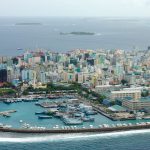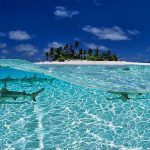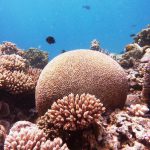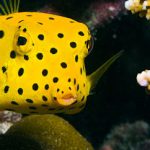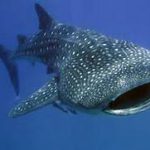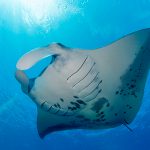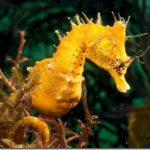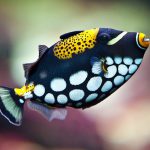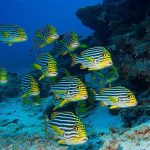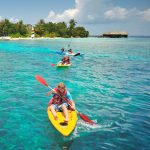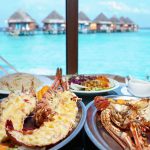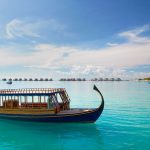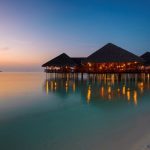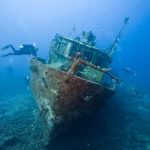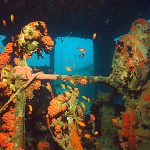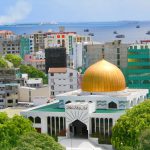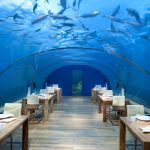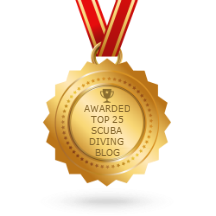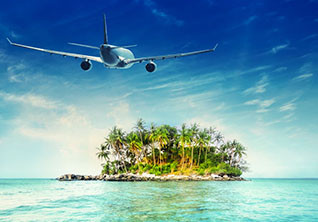The Maldives: A Garland of Islands
In The Indian Ocean.
The Maldives attractions include spectacular underwater creations for scuba diving thousands of fish and coral species. Topside, white sandy beaches rise just above sea level. Twenty six atolls and just fewer than 1200 islands form a chain from just below the equator to 804 km (500 miles) north. The average height of the land is 1.5m (4”11”) above sea level and the highest point is 2.4m (7’10”). It all started some 65 million years ago when a volcanic mountain range sprouted up above the surface in almost a straight row then gradually began to subside. Corals had time to grow micro layer by micro layer and form great communities around the volcanoes before earlier generations were forced downwards during bouts of subduction to depths as deep as 2100m (6400ft).
As for history, Sanskrit writings mention these islands as early as 500BC when sailors from India and the island of Java crossed through the Maldives on their way to trade with Madagascar and the eastern shores of Africa. The local Maldivian Buddhists converted to Muslim in the 12th century and the Maldives were given independence from England in 1965. In 1972 tourism began with two resorts, and now there are over 92 resorts spread out over 65 islands. While there are a few land based dive resorts, there are over 30 dive liveaboard operations. Tourism has become a major component of their economy and it’s safe to say that more than twice the number local Maldivians visit the islands each year.
So what’s the big attraction in the Maldives? Turns out that the big attractions for scuba diving are whale sharks and mantas. With the small attractions including frogfish and seahorses. The islands are home to 1100 species of fish, 5 species of turtles, 187 species of coral, 145 species of crab, 48 species of shrimp, 21 species of whales and dolphins…you get the idea. Add 483 species of mollusks and echinoderms, and you have a recipe for filling hard drives, flash drives, and camera memory cards. But to be honest, we’re not really sure how many images of a seahorse, clown triggerfish, or manta at a cleaning station one can take before ever being really satisfied?
And speaking of endless lists, how about the local accommodations? You can stay in accommodation on land, huts over the open ocean, rooms with infinity pools or you can adventure out and see more variety on a dive liveaboard. For lunch, you can dine in your cabana, at the main lodge, feast at a tented table at the end of a jetty, boat out to a secluded beach, or fine dine in an underwater restaurant which can be a one of a kind experience or an awkward experience if you ordered the catch of the day and you notice a school of fish looking at you in distain. And when it comes to water sports, Maldivians have a list of everything ready to try out from kayaking, jet skiing, snorkeling, scuba diving, to submarines, and whale watching.
So when is the best time to dive here? Well to start off, the Maldives have two seasons. The Southwest season is wet with monsoon rains and this season goes from April or May until November with June to August having the most rain. During this time, There can be large plankton blooms that bring in large pelagics and visibility can range from 20-40 meters (65- 130plus) feet. The eastern side of the Maldives is where the Mantas and whale sharks will be most likely viewed during this season. The Northeast season on the other hand from December thru April/May, is dry and brings slightly warmer and calmer waters to the islands. The eastern side will have sharks and pelagics, but the mantas and whale sharks will be hanging out on the western side of the Maldives during this season. The northeast season is also when the liveaboard vessels head down south towards the equator, or you can board more northern exploring liveaboards at this time. The stronger currents that flowed in January will calm down and give rise to slack currents during March and April. But with this being said, our own experiences coupled with multiple feedback reports verify that the best time to visit the Maldives is year round and repeatedly.
So what about the dive sites? Unlike some vague dive site names such as found in mostly English speaking countries in the world, the Maldivians (even though many speak English) have perfected the names of dive sites and it’s almost amazing what you can discern with only knowing four words in their home language of Dhivehi. So for all future reference, Kandu means channel, a Faru is a reef rising up in a channel, a Thila is a reef or pinnacle reef rising up inside an atoll, and a Giri is like a thila, but much smaller. When you have a thousand islands, this system makes every dive site easier to remember. Take the popular dive sites such as Fotteyo Kandu, Hembadhu Kandu, and Ziyaara Kandu. Just by the name you already know they are channel dives and most likely have caves, overhangs, swim throughs, small arches, or they lead to small reefs and have sharks, turtles, moray eels, schools of fish, and eagle rays swimming by on their way to work or Mantas stopping by the local cleaning stations. Kuda Faru, and Eri Faru are reefs in the channels where one would expect to find gray sharks, white tips, silver tips, Napoleon wrasse, coral, and invertebrates. Okobe Thila, Kudarah Thila, Mas Thila, all tell you that you will see tons of corals and schools of red teethed triggerfish, snappers, fusiliers, sweet lips, and more. Of course there are some dive site names in English that are rather precise and some popular ones include: Manta Point, Hammerhead Point, and Turtle Beach. Other popular sites with no clue in the name include: Three Palms for looking at nudibranchs, and Vacation Home Center for a variety of everything living in shallow to deep waters.
Of course there are over 2000 years worth of wrecks scattered around the channels, atolls, and deep reefs, but a few of the popular wrecks include the 35,000 ton Victory freighter, The Fesdu fishing trawler, the Halaveli cargo wreck and the Shipyard where two vessels rest near each other with Skipjack 1 resting at a vertical angle against the reef and the Skipjack 2 resting horizontal in the sand on its portside and both can be visited on one dive if currents permit.
So as you can imagine, it’s hard to visit all the possible dive sites in one single trip, no matter which season you choose, but it’s even more difficult to imagine that all the Maldives could become uninhabited within the next 80 years, as glaciers melt and the sea levels continue to rise and are predicted to increase by some 2m (6ft) in height by 2099 in a best case scenario as predicted by the majority of world leading scientists; although this well defined theory is not deemed accurate according to a the scientifically challenged. Either way, this unique Garland of islands comprised of 26 atolls needs to be preserved, protected, and profusely perused by you.


